31 Days, 31 Books: 2023 Wordless Picture Books

Every wordless picture book you see is taking a risk. When you notice that one has been published, that means that its creator(s) argued successfully that they were capable of telling a comprehensible story without the aid of a single word. Getting a picture book published in the first place is a massive undertaking, and to add onto that the risk inherent in going totally wordless? Today I am saluting these little hero books. They not only took on the challenge of eschewing written communication, but they did so successfully and with aplomb. We should all be so talented.
You can find a full PDF of today’s list here.
Love wordless titles? Then check out some lists from previous years:
2023 Wordless Picture Books
Afterward, Everything Was Different by Rafael Yocktend, ill. Jairo Buitrago, translated by Elisa Amado
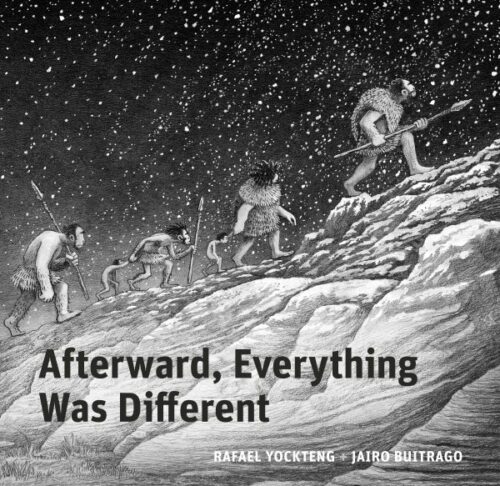
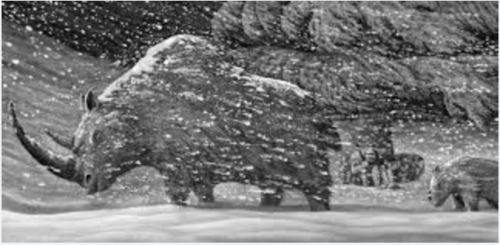
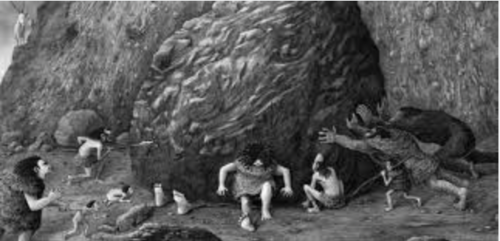
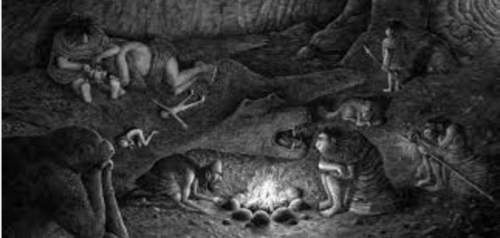
A group of early humans struggles to survive during the Pleistocene era. Meanwhile, a single girl watches and records everything that happens to them for posterity. An epic wordless tale about our earliest ancestors. I hereby declare 2023 The Year of the Wordless Picture Book. Between this and Aaron Becker’s The Tree and the River, we’re seeing massive time periods covered without a word on the page. Amazingly, this book highlights that impossible moment where humanity went from just trying to exist to trying to tell our stories to one another. It’s black and white, but you quickly forget about all that as you follow this group of humans (and their a human-adjacent friend, which I kind of love) tromping about during the Pleistocene era. I love the cinematic opening and it’s interesting watching their numbers deplete over time. I could read this again and again and notice something new with each read. Wholly, utterly engaging and original. Previously Seen On: The Translation List
ADVERTISEMENT
ADVERTISEMENT
The Book From Far Away by Bruce Handy, ill. Julie Benbassat
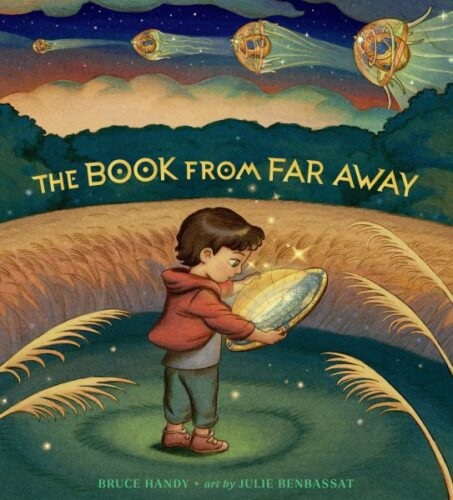
Oo! A twofer! Not only will you find that this is a book without words, but it has a nice little science fiction component as well. I’m a huge fan of science fiction picture books (at most you might find three in a given publishing year) and glom onto them the moment I see them. This book? Infinitely glommable. It’s always a nice plus when the book is beautiful and good in addition to being an interesting idea. The concept behind this story is that an alien family has landed on our planet to have a picnic. A human boy spies them and finds that after they’ve left they’ve forgotten a strangely elaborate circular disc. Brass and blue and filled with symbols and heavenly bodies, some experimentation reveals that it appears to turn some kind of translucent pages. The boy is enamored but all too soon the alien boy reappears and the two manage, in spite of the language gap, to communicate. The human boy shares one of his own picture books with the alien child (100 points if you can identify that book) and then he’s gone. But what’s this? Peek in the boy’s backpack and you can see the original alien book is still in there. These two will grow up to be linguists, no doubt (the whole thing felt very Arrival to me). There were so many small things about this book that I liked, in addition to the smooth illustrations. I really was quite partial to how mournful the alien mama looked at all times. Not sad, exactly, but pensive. I loved the twist and the amount of work that went into the alien’s “book” (it reminded me of the Golden Compass from the Philip Pullman book of the same name). All told, one of the most inventive little books of the year.
Bunny & Tree by Balint Zsako
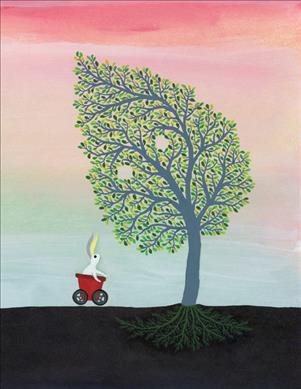
So wordless that its title doesn’t even appear on its cover! When a little white bunny befriends a stately tree, the two set off on a wild adventure to find other bunnies in the world in this dreamy wordless work of storytelling. I can already tell that we’re going to have to have a whole discussion about whether or not this constitutes a “picture book” or not when, technically, it’s clocking in at a mighty 184 pages. I just consider this a particularly long picture book, though. Granted, there’s a certain level of sophistication at work here that requires not simply a basic working knowledge of sequential art, but also the understanding to make the leap between what seems possible and what seems utterly impossible. The watercolors are completely lovely and dreamy and I suspect you could have some interesting conversations with a kid about what precisely is happening in one scene or another (are those the same bunnies at the end as those at the beginning of the story?). Very cool.
The Greedy Worm by Jeff Newman
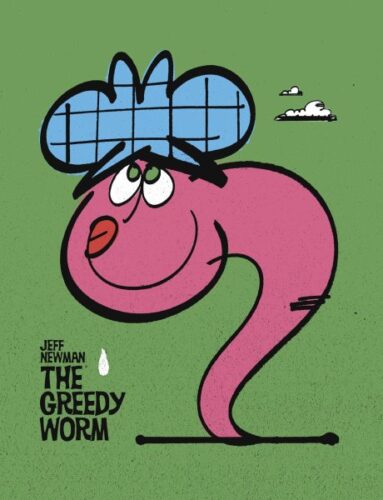
There are certain author/illustrators of picture books out there who only produce something every so often. The trick is to keep your eyes peeled and wait patiently until you spot them in the wild. I’ve been a big time fan of Jeff Newman for years (and maintain that his book The Boys is one of the great wordless lost classics of the early 21st century). Over the years the man has proved himself a deft hand with telling stories with a minimum of words, while also providing art heavily influenced by that general Gerald McBoing Boing era of animation/fiction. In this story a green-eyed worm (in more ways than one) doffed in a blue cap observes a ginormous apple. Delight turns to disappointment when he realizes that other insects are also interested in it. Newman creates an evil grin straight out of the Chuck Jones How the Grinch Stole Christmas school as the worm determines to eat the dang thing single-handedly all by himself. A comeuppance is in the coming, you bet, but the good-hearted fellow bugs come to his aid anyway and things come to a happy end. I was particularly taken with the worm’s beard (grown to show the passage of time) near the end. Worth multiple reads, I’d say.
The Light Inside by Dan Misdea

I worry about this book. On a practical librarian level, I mean. It’s just so small. Clocking in at a petite 5.75 inches up and across, I know that a lot of libraries will catalog is as part of their Holiday collections. This makes sense since it’s full of Halloween-appropriate characters. What chaps my hide is that after it had its initial day in the sun they’ll take it to the part of the library where all the holiday books go and it will disappear. I mean, it’s not that much bigger than a Beatrix Potter book and I think we all know how those tiny titles have a tendency to snuggle deep into the stacks, never to be found again. Still, for those children who do find it, the story is just so lovely. Wordlessly, it tells the tale of a pumpkin headed child (I love how just the tip of mom’s green stem sticks out of her hair) who is initially afraid of the creatures that dwell in the dark but, finds it must confront them when its prized mouse stuffie is stolen by a black cat. Looking at Misdea’s art, I was reminded of the work of Liniers. I thought maybe Misdea might have an underground comix background, but turns out he’s a New Yorker cartoonist that we’ve undoubtedly seen before. He is also the nephew of none other than fellow children’s book creator, and syndicated cartoonist, Patrick McDonnell. Misdea has his own small, spare style distinctly his own, but very much in keeping with his uncle’s tone. I see big things for his little books in the future. Previously Seen On: The Holiday list
Olive by Jed Alexander

ADVERTISEMENT
ADVERTISEMENT
Forget Jack and the beanstalk. Meet Olive and the beanstalk! A wordless adventure takes Olive to the skies where she discovers that size is relative when you have a friend. Jack and the Beanstalk gets a kick in the pants with this clever retelling of the old fairy tale. The Jack story has been done to death in picture books, actually, but there is something especially fresh and interesting about what Jed Alexander is doing here. I absolutely love how the book is able to wordlessly parallel how Olive feels with the giant, alongside how she feels when she’s a giant to another small creature. It’s about taking responsibility for those smaller than you, and remembering your place. Love the metaphor, love how comfortable the giant is in her own body, and love the wordless storytelling. Previously Seen On: The Fairy Tales list
Once, a Bird imagined by Rina Singh, ill. Nathalie Dion

Oh, I like that. “Imagined by Rina Singh” rather than “Written by”. After all, this is a wordless book, and it’s always hard to know precisely how to credit such books’ authors. Maybe this will become the standard for the industry. In this story a robin travels far distances to find a proper place to roost and nest. You get these marvelous, soaring views from high above in a robin’s p.o.v., sometimes higher and higher. Now the copy on the book has a description of this story that caught my eye. It says, “Once, a bird brought a community together. The streets are empty and the playground still. Puzzled but determined, the bird looks for a place to nest.” That makes this book sound like a pandemic title, and maybe that was its purpose. When I read it without having read this description first, though, I didn’t pick up on all of that. I was probably more puzzled that there is no second robin at any point. Those eggs seemingly come out of nowhere!. Ah well. As wordless tales go, this is a clever one, and great for giving you a bird’s eye view of flight.
The Tree and the River by Aaron Becker




A single tree sits on the small peninsula as civilizations rise and fall around it. A beautiful detail-rich wordless story of human hubris and hope. Oh yes! Becker’s back! Some of you may recall his Journey series from a couple years ago. It was an epic three-part wordless fantasy series in picture book form. Then Becker made A Stone for Sascha which felt more like a prelude to this book than anything else. Now he’s returned with another epic wordless story, and this one feels like more like a Mitsumasa Anno boo, of which I thoroughly approve! There is just so much for kids to pick apart in this wordless storyline. Who won the war? How have the two cultures seen in the book integrated? How is this a book about what might happen to us in the future? In spite of the fact that the world clearly floods due to a global warming of some sort, the book ends on a pretty hopeful note. No small task for something completely wordless. One of the most accomplished picture books of the year. Also, because I am just that petty, I would like to point out that my review called out that Planet of the Apes moment at the beginning of the book long before anyone else’s. *grabs all her toys and runs away*
Yellow Butterfly by Oleksandr Shatokhin

Much like the rise of picture books about refugees that came out in the wake of Syria’s crisis, so too have Ukrainian picture books proliferated in the last year or two due to the Russian invasion. Finding a way to appeal to notoriously apathetic American consumers and their children is a challenge for any publisher, so perhaps wordless books really are the smartest method of conveying information about war. Oleksandr Shatokhin, a Ukrainian artist who is, according to this biography on the back bookflap, still living and working in Ukraine, does something infinitely clever with this title. It’s really all about the imagery. Unexploded bombs. Barbed wire. And, of course, the yellow butterfly. The book begins in black and white, which means that when the butterflies swarm upon the lines of barbed wire against the blue sky, the final effect bears resemblance to nothing so much as the Ukrainian flag (clever). Red Comet Press made sure to include information at the end on how to share a wordless book, as well as tips for guiding a conversation about the war. A clever way to bring a hard subject to the youngest of readers.
Hope you enjoyed these! Here are the lists you can expect for the rest of this month:
December 1 – Great Board Books
December 2 – Picture Book Readaloud
December 3 – Simple Picture Book Texts
December 4 – Transcendent Holiday Picture Books
December 5 – Rhyming Picture Books
December 6 – Funny Picture Books
December 7 – CaldeNotts
December 8 – Picture Book Reprints
December 9 – Math Books for Kids
December 10 – Gross Books
December 11 – Books with a Message
December 12 – Fabulous Photography
December 13 – Translated Picture Books
December 14 – Fairy Tales / Folktales / Religious Tales
December 15 – Wordless Picture Books
December 16 – Poetry Books
December 17 – Unconventional Children’s Books
December 18 – Easy Books & Early Chapter Books
December 19 – Older Funny Books
December 20 – Science Fiction Books
December 21 – Fantasy Books
December 22 – Comics & Graphic Novels
December 23 – Informational Fiction
December 24 – American History
December 25 – Science & Nature Books
December 26 – Unique Biographies
December 27 – Nonfiction Picture Books
December 28 – Nonfiction Books for Older Readers
December 29 – Audiobooks for Kids
December 30 – Middle Grade Novels
December 31 – Picture Books
Filed under: 31 Days 31 Lists, Best Books, Best Books of 2023
About Betsy Bird
Betsy Bird is currently the Collection Development Manager of the Evanston Public Library system and a former Materials Specialist for New York Public Library. She has served on Newbery, written for Horn Book, and has done other lovely little things that she'd love to tell you about but that she's sure you'd find more interesting to hear of in person. Her opinions are her own and do not reflect those of EPL, SLJ, or any of the other acronyms you might be able to name. Follow her on Twitter: @fuseeight.
ADVERTISEMENT
ADVERTISEMENT
SLJ Blog Network
Name That LEGO Book Cover! (#53)
Exclusive: Vol. 2 of The Weirn Books Is Coming in October | News
Fighting Public School Book Bans with the Civil Rights Act
North Texas Teen Book Festival 2024 Recap
ADVERTISEMENT








ONCE, A BIRD is one I will consider giving to my young toddler friend who has shown much interest in birds. If not appropriate right now because of her age, I know the book can be saved for later.
I’m looking forward to reading OLIVE. What an interesting cover!
At a book launch years ago, I heard Mark Pett (author/illustrator of the delightful, wordless books, THE BOY AND THE AIRPLANE and THE GIRL AND THE BICYLE) say that one thing he values about wordless picture books is that young children are as competent at reading them as literate adults. (Maybe even MORE competent?) True, true. 🙂